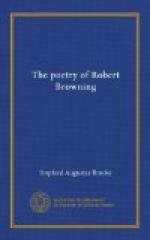Then who will may read the dazzling account of the streets of Ferrara thick with corpses; of Padua, of Bassano streaming blood; of the wells chokeful of carrion, of him who catches in his spur, as he is kicking his feet when he sits on the well and singing, his own mother’s face by the grey hair; of the sack of Vicenza in the fourth book; of the procession of the envoys of the League through the streets of Ferrara, with ensigns, war-cars and clanging bells; of the wandering of Sordello at night through the squares blazing with fires, and the soldiers camped around them singing and shouting; of his solitary silent thinking contrasted with their noise and action—and he who reads will know, as if he lived in them, the fierce Italian towns of the thirteenth century.
Nor is his power less when he describes the solitary silent places of mediaeval castles, palaces, and their rooms; of the long, statue-haunted, cypress-avenued gardens, a waste of flowers and wild undergrowth. We wander, room by room, through Adelaide’s castle at Goito, we see every beam in the ceiling, every figure on the tapestry; we walk with Browning through the dark passages into the dim-lighted chambers of the town palace at Verona, and hang over its balconies; we know the gardens at Goito, and the lonely woods; and we keep pace with Sordello through those desolate paths and ilex-groves, past the fountains lost in the wilderness of foliage, climbing from terrace to terrace where the broken statues, swarming with wasps, gleam among the leering aloes and the undergrowth, in the garden that Salinguerra made for his Sicilian wife at Ferrara. The words seem as it were to flare the ancient places out before the eyes.
Mixed up with all this painting of towns, castles and gardens there is some natural description. Browning endeavours, it is plain, to keep that within the mediaeval sentiment. But that he should succeed in that was impossible. The mediaeval folk had little of our specialised sentiment for landscape, and Browning could not get rid of it.
The modern philosophies of Nature do not, however, appear in Sordello as they did in Pauline or Paracelsus. Only once in the whole of Sordello is Nature conceived as in analogy with man, and Browning says this in a parenthesis. “Life is in the tempest,” he cries, “thought
“Clothes the keen hill-top;
mid-day woods are fraught
With fervours”:
but, in spite of the mediaeval environment, the modern way of seeing Nature enters into all his descriptions. They are none the worse for it, and do not jar too much with the mediaeval mise-en-scene. We expect our modern sentiment, and Sordello himself, being in many ways a modern, seems to license these descriptions. Most of them also occur when he is on the canvas, and are a background to his thought. Moreover, they are not set descriptions; they are flashed out, as it were, in a few lines, as if they




